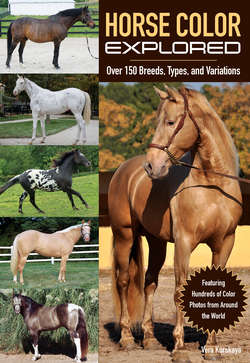Читать книгу Horse Economics - Vera Kurskaya - Страница 48
На сайте Литреса книга снята с продажи.
Cream Plus Champagne—And Other Colors Determined by Champagne
ОглавлениеA previously used term for horses who have one Champagne allele and the Cream Dilution allele was “ivory.” However, the term “ivory” does not reflect the genetic nature of the colors of this group, and it has been recommended by the ICHR to use compound names containing the names of the genes/alleles involved instead. As an example: the color resulting from the combination of amber champagne with Cream Dilution is called amber cream.
The genetic base of such colors can be any—chestnut, black, bay, or seal brown. The genotype usually consists of one or two Cream Dilution alleles (Ccr) and one or two Champagne alleles.
Horses in this group are born with light pink skin that becomes covered by dark specks with age. Eyes at birth can be light blue, and with age they can become light green or amber—all being characteristic signs of champagne colors. The dilution of pheomelanin caused by the Cream allele combined with dilution of both types of melanin by the Champagne gene can have a varying effect, thus complicating color identification. It is possible to define color most precisely by DNA analysis. Here I will consider only those combinations that have authentic representative carriers and for which there is real phenotypic data, but note that other combinations are also possible.
Amber cream horses have pale yellow—sometimes almost white—body color and a light brown mane and tail. The lower part of the legs is occasionally a little darker brown. Gold cream horses have very pale yellow or ivory color body hair (Photos 71 & 72). Compared to amber cream, gold cream is lighter. As a rule, the mane and tail are white or pale cream. The eyes are yellow or golden, but occasionally can remain blue for the rest of the horse’s life. A sable cream horse is similar to amber cream, but the color of the body, mane, and tail has a subtle brown shade.
Classic cream champagne horses are light bluish smoky color, sometimes almost white with a yellowish shade (Photo 73). The mane and tail are light brown with an admixture of reddish hair. In 2009, the ICHR began registering double cream champagne color. Such horses look almost white, but in good light it is possible to notice a pale shade of ivory or light cappuccino, and a weak golden gloss in the sun. The skin is pink and dark specks can be absent completely. If they are present, there are few and they are difficult to find. The skin of this horse is lighter than the skin of a double cream dilute. The eyes are ivory and have blue streaks running up and down from the pupil. The iris can be framed with a yellowish ring on the outer edge.
There are additional colors determined by the Champagne gene combined with other dilution genes, besides Cream. Champagne dun horses have a strongly diluted color similar to dun with noticeable primitive markings in coffee or dark gold. Most often this combination is found in Quarter Horses. Classic dun and classic grullo horses (see p. 24) differ from champagne dun in the whitish-ashy body hair and light-chocolate guard hair. Sable dun color looks similar, but is lighter, while gold dun animals have body hair that is light cream or light amber with a mane and tail that are ivory or white. Amber dun is a beige body color with pale brown guard hair and lower legs. The eyes of champagne dun horses of any shade described here are most often light green.
Silver champagne horses combine the action of both dilution genes. The resulting amber silver horse has a light pinkish-amber or light ashy body color, and the lower parts of the legs are the same shade or are slightly darker. The mane and tail may contain whitish hair.
Quite often you can find combinations of champagne with spotting or an Appaloosa-like pattern.
The ICHR separates a group of colors called triple dilutes. Here belongs the double cream champagne color described above, as well as other combinations of three dilution genes. For example, classic cream dun is a black-based horse carrying one gene of each: Cream, Dun, and Champagne. There are also other combinations, but their external differences are insignificant, and therefore, it is necessary to determine such colors by DNA analysis.
